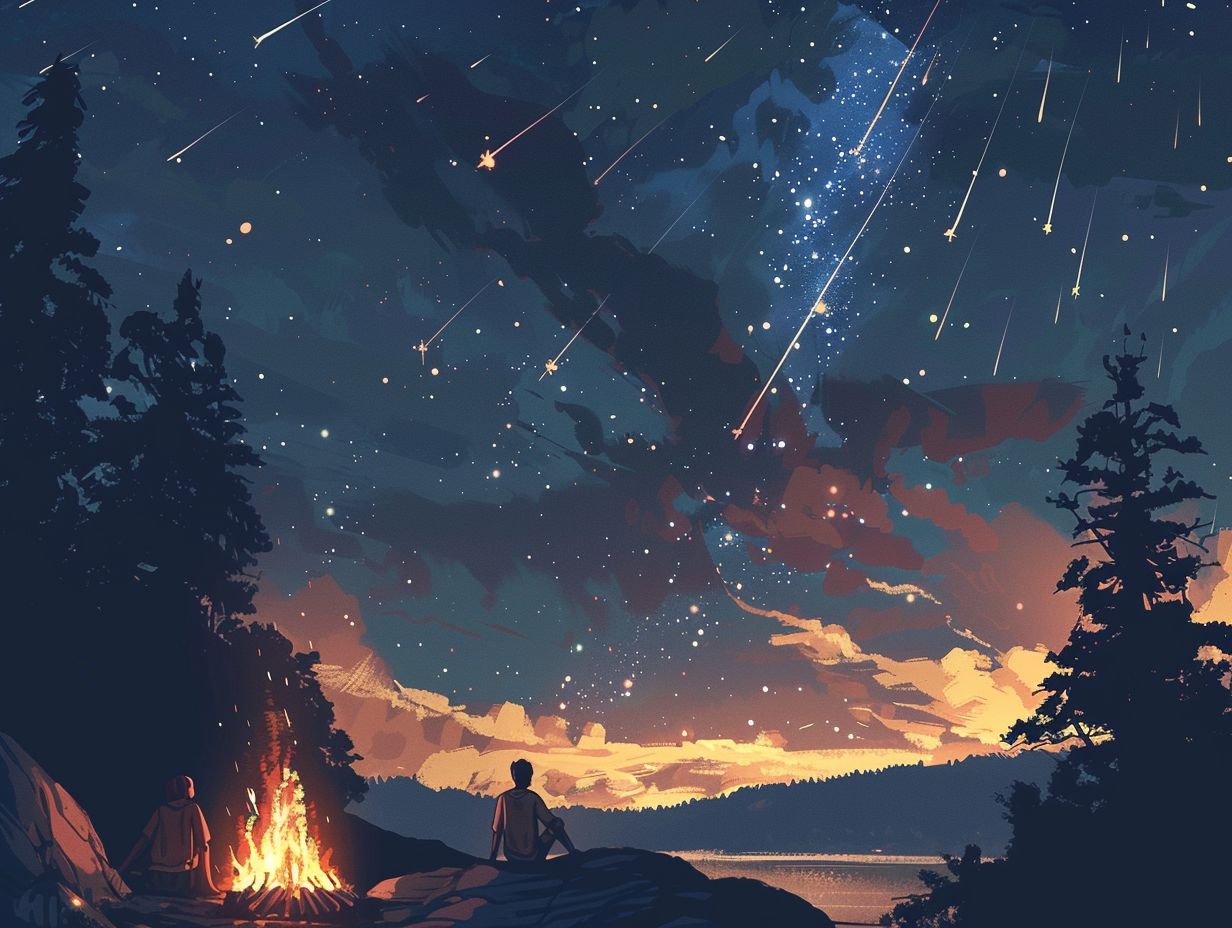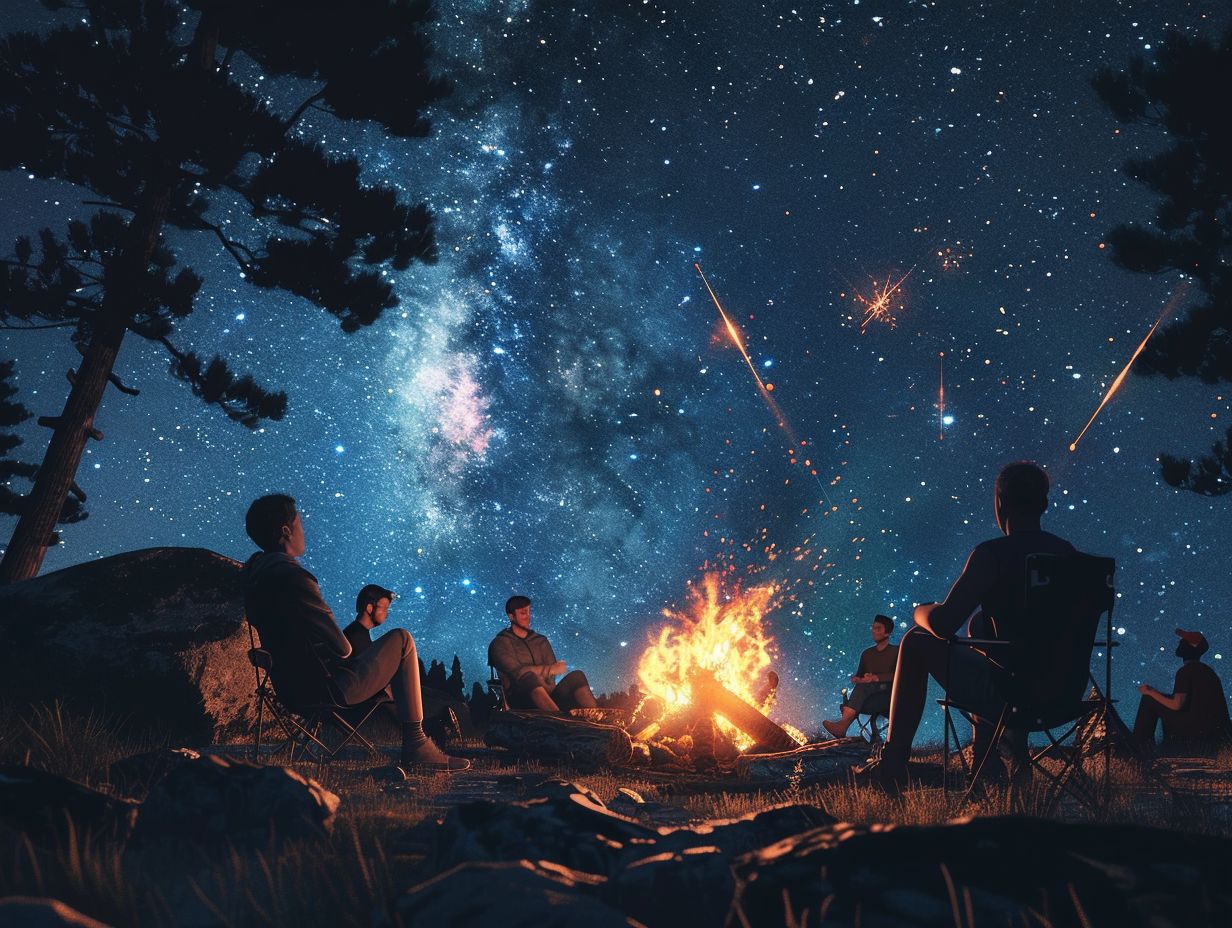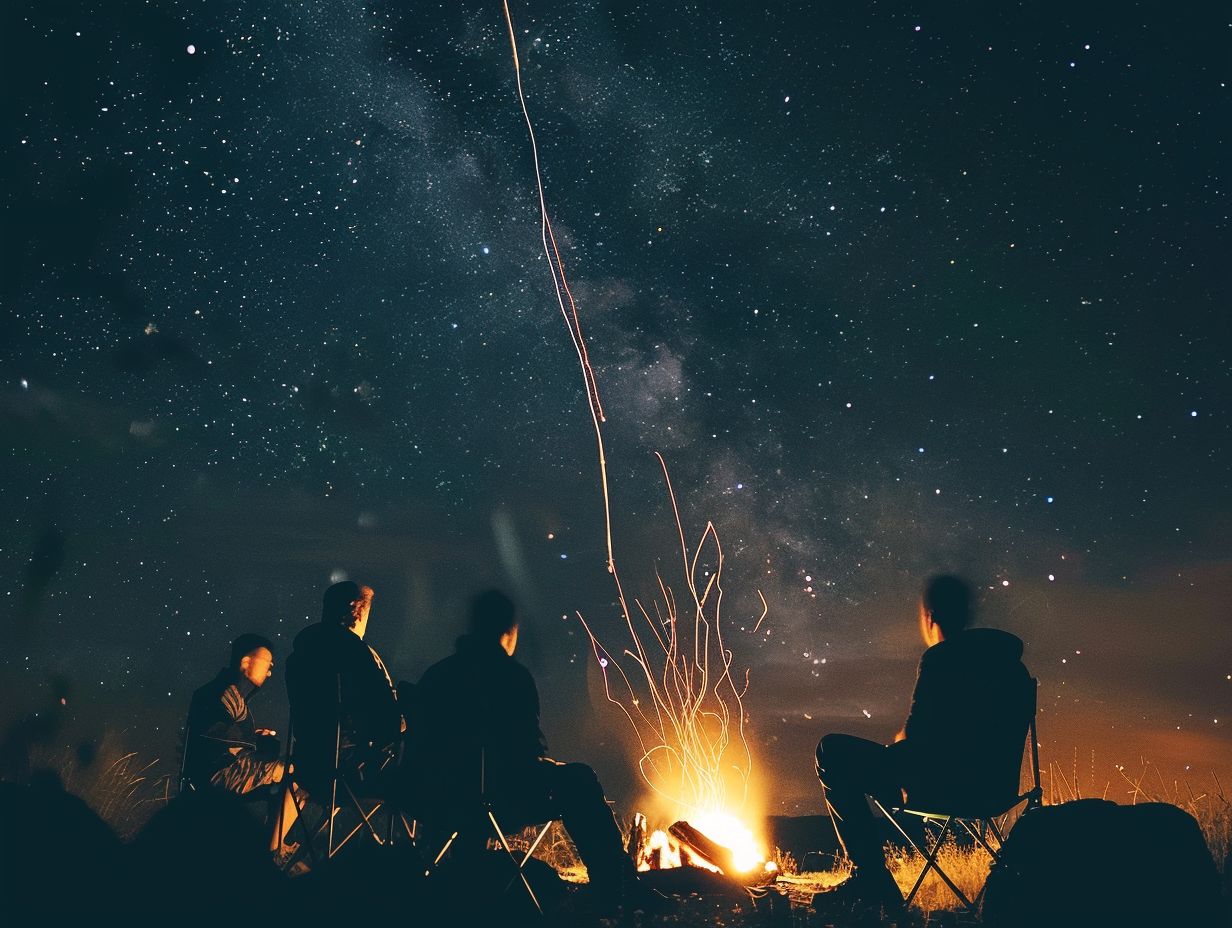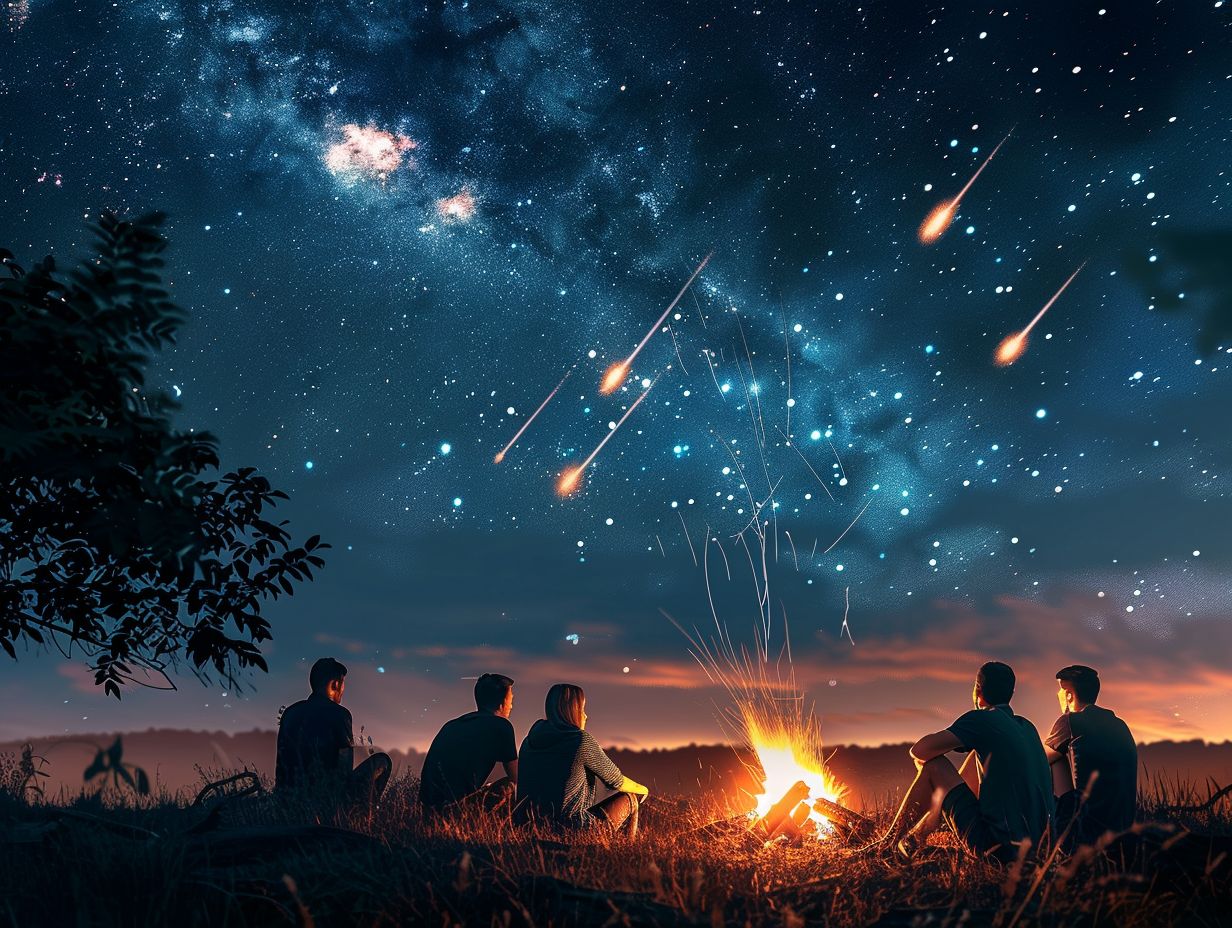Meteor showers are considered one of the most spectacular natural phenomena that you can witness from Earth. This article will delve into the excitement and wonder that accompanies experiencing a meteor shower up close. From selecting the optimal time and location to necessary camping gear, preparations for various weather conditions, and ensuring safety during the journey, all aspects will be covered to help you maximise your experience of this awe-inspiring event.
Therefore, gather your equipment and prepare for an unforgettable adventure beneath the starry skies!
Key Takeaways:

- Choose the right time and location to experience meteor showers, researching schedules and finding dark sky spots to optimise your viewing experience.
- Prepare essential gear for camping during meteor showers, including a packing checklist and must-have items to stay comfortable and prepared for changing weather conditions.
- Stay safe and make the most of your trip by exploring the surrounding area, taking necessary precautions for the environment, and following tips for viewing and capturing photos of meteor showers.
What are Meteor Showers and Why They are Worth Seeing
When you witness a meteor shower, you are experiencing a celestial event where multiple meteors appear to emanate from one specific point in the night sky. This awe-inspiring phenomenon serves as a powerful connection between humanity and the vast expanse of the cosmos, prompting contemplation of the beauty and marvel of celestial occurrences.
Throughout these events, luminous streaks of light illuminate the darkness above, crafting a captivating spectacle of fiery trails set against the stellar backdrop. Various cultures across history have regarded meteor showers as spiritual or mystical phenomena, interpreting them as messages from the heavens or signs of impending change.
Enthusiastic stargazers eagerly await these displays, strategically planning their evenings to optimise viewing conditions and catch glimpses of shooting stars.
To maximise your viewing experience, seek out a dark location free from city lights, bring along a comfortable blanket, and allow your eyes adequate time to adjust to the darkness for optimal meteor shower observation.
Choosing the Right Time and Location
To maximise your stargazing experience and observe meteor showers in their full splendour, it is crucial to carefully choose the right time and location. By scouting for dark sky spots and identifying optimal meteor shower locations, you can enhance the anticipation and excitement of your celestial adventure.
Researching Meteor Shower Schedules and Finding Dark Sky Spots
Before embarking on your stargazing adventure, it is imperative to conduct thorough research on meteor shower schedules and pinpoint prime dark sky locations where celestial events are most visible. Using stargazing apps can help you identify optimal viewing spots such as Cherry Springs State Park and Big Bend National Park.
These applications offer real-time updates on upcoming meteor shower events like the Perseids and Geminids, allowing you to plan your stargazing activities well in advance. By using features like sky maps and event notifications, you can enhance your chances of witnessing meteor showers at their peak.
Exploring well-known stargazing sites like Mauna Kea in Hawaii or Death Valley National Park in California can offer unparalleled opportunities for observing the night sky in all its glory.
Essential Gear for Camping During Meteor Showers
When preparing for a night of stargazing during meteor showers, it is crucial to have the appropriate gear for an exceptional experience. Bringing along stargazing equipment such as binoculars, telescopes, and star charts, in addition to camping gear, will ensure that you are fully equipped to fully immerse yourself in the celestial marvels above.
Packing Checklist and Must-Have Items
When preparing for your stargazing camping trip, it is crucial to create a comprehensive packing checklist to ensure you have all the necessary items for a comfortable and enjoyable experience. Essential items such as a durable camping setup, a folding chair for extended sky observation, and insect repellent for added comfort should be included without fail.
Along with these essentials, do not overlook packing a telescope or binoculars to enhance your stargazing experience by observing celestial bodies up close. A star chart or stargazing app can serve as invaluable tools to help you navigate the night sky and identify constellations.
To stay warm during nighttime stargazing sessions, be sure to bring a cosy blanket or sleeping bag, and a portable camping stove will allow you to enjoy hot beverages while marvelling at the stars above. Remember to pack snacks and water to keep yourself nourished and hydrated throughout the night.
Preparing for the Weather and Environment

Before heading out to observe meteor showers in the great outdoors, it is essential for you to prepare for the diverse weather conditions and environmental factors that you may encounter. Layering clothing to stay warm, taking the forecast into account, and showing respect for nature’s elements all contribute to a safe and pleasant stargazing experience in national parks and camping sites.
Tips for Dealing with Cold, Rain, and Other Conditions
Navigating through challenging weather conditions like cold nights or unexpected rain showers is part of the stargazing adventure. Implementing safety precautions, having emergency plans in place, and staying informed about navigation tips can help you deal with various conditions while ensuring your safety during meteor showers and celestial events.
One crucial tip for you is to dress in layers to stay warm and dry. Wearing moisture-wicking clothing under a waterproof outer layer can protect you from sudden changes in weather. Carrying a reliable weatherproof backpack with essentials like a first aid kit, torch, navigation tools, and extra food and water is essential in case of emergencies.
You should familiarise yourself with the area’s terrain and have a backup communication plan in case you lose signal. These preparations will not only enhance your stargazing experience but also keep you safe during adverse weather conditions.
Activities to Do During the Day
Whilst waiting for the nighttime display of meteor showers, daytime exploration provides a plethora of activities to enhance your stargazing adventure. Whether you choose to immerse yourself in the natural splendour of the area or embark on a road trip to camping destinations across the U.S., there are numerous opportunities for adventure during the daylight hours.
Exploring the Surrounding Area and Making the Most of Your Trip
When venturing beyond your campsite to explore the wonders of nearby national parks or embarking on a stargazing road trip, you can add depth and excitement to your meteor shower experience. Discovering celestial events in the U.K. and Canada while on the road can enhance the allure of your stargazing adventure.
Whether you find yourself in the vast wilderness of Yellowstone National Park, where clear skies offer an unobstructed view of the cosmos, or in the tranquil surroundings of Banff National Park, each destination presents a unique opportunity for you to witness the beauty of celestial displays.
During your stargazing road trip, make sure to visit locations like Acadia National Park or Jasper National Park, known for their dark skies that provide an ideal setting for you to marvel at meteor showers and other celestial phenomena.
Tips for Viewing Meteor Showers
To enhance your meteor shower viewing experience, it is recommended that you utilise expert tips and techniques. By mastering astrophotography and utilising a star chart for orientation, especially during events like the Perseid meteor shower, you can elevate your stargazing experience to new heights.
Optimising Your Viewing Experience and Capturing Photos
Enhancing your viewing experience and capturing celestial moments through photography requires the utilisation of the right tools and techniques.
When engaging in astrophotography during events like the Geminids Meteor Shower, it is important to use telescopes, binoculars, and stargazing apps to ensure optimal results.
Telescopes with higher magnification power are essential for bringing distant galaxies and nebulae into sharp focus, allowing for the observation of intricate details in the night sky.
Pairing binoculars with a sturdy tripod can help stabilise your view and enhance the clarity of your celestial snapshots.
Additionally, utilising stargazing apps such as Star Walk or SkySafari can be beneficial in locating specific constellations and planets for optimal astrophotography opportunities, particularly during meteor shower events like the Perseids or Leonids.
Staying Safe During the Trip

Prioritising your safety and well-being throughout your stargazing journey is essential for a remarkable experience under the night sky. By implementing safety precautions, establishing emergency plans, and selecting Dark Sky Parks for secure viewing environments, you can enhance your peace of mind while engaging in celestial explorations.
Important Safety Precautions and Emergency Plans
Prioritising safety through adequate precautions and well-thought-out emergency plans is essential for a smooth and secure stargazing journey. Whether you are visiting International Dark Sky Places or remote celestial spots, having safety measures in place will ensure a worry-free exploration of the night sky.
It is crucial that you familiarise yourself with the specific regulations of the stargazing location and adhere to the guidelines set by park rangers or local authorities. Additionally, carrying essential emergency supplies such as a first aid kit, torch, extra batteries, and water is imperative for any stargazing excursion.
Staying informed about weather conditions and potential hazards, such as wildlife or rough terrain, can assist you in avoiding unforeseen dangers. Developing a communication plan with fellow stargazers or informing a trusted person about your whereabouts and expected return time will enhance overall safety protocols during nighttime stargazing activities.
Frequently Asked Questions
What are meteor showers and why should I plan a camping trip around them?
Meteor showers are a spectacular phenomenon that occur when Earth passes through debris left behind by a comet or asteroid. This results in a display of shooting stars lighting up the night sky. Planning a camping trip around meteor showers allows you to witness this stunning event in a natural and uninterrupted setting.
When is the best time of year to plan a camping trip around meteor showers?
The best time to plan a camping trip around meteor showers is during the peak of a meteor shower. The two most well-known meteor showers, the Perseids and Geminids, occur in August and December respectively. However, there are smaller meteor showers throughout the year that can still provide a good viewing experience.
Where is the best location to camp for meteor shower viewing?
The best location to camp for meteor shower viewing is in an area with little to no light pollution. This could be a designated dark sky park, a remote camping spot, or even your own backyard if it offers a clear view of the sky. It’s important to also check the weather forecast beforehand to ensure clear skies for optimal viewing.
How do I prepare for a camping trip around meteor showers?
First, make sure you have all the necessary camping gear such as a tent, sleeping bags, and cooking supplies. It’s also important to pack warm clothes and blankets as temperatures can drop at night. Don’t forget to bring a red light or headlamp to preserve your night vision while stargazing. Lastly, research the specific meteor shower you’re planning to see to know the best time to view it.
Can I bring a telescope for meteor shower viewing during my camping trip?
Yes, you can bring a telescope for meteor shower viewing during your camping trip. However, keep in mind that the best way to view meteor showers is with the naked eye since they can appear anywhere in the sky. A telescope may limit your field of view and make it more difficult to see the shooting stars.
Are there any safety precautions I should take during my camping trip around meteor showers?
Yes, there are a few safety precautions to keep in mind during your camping trip around meteor showers. Make sure to have a first aid kit on hand, as well as a map and compass in case you get lost. It’s also a good idea to let someone know your camping location and expected return time. Lastly, be aware of any potential wildlife in the area and store food properly to avoid attracting animals to your campsite.




